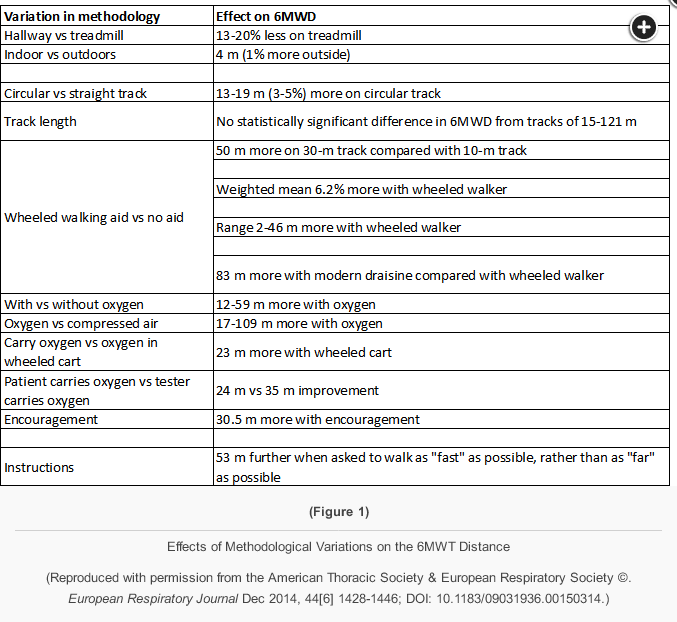6 minute walk test 6mwt
- related: Pulmonology
- tags: #literature #pulmonology

The 6MWT is a safe, simple, and practical test of functional capacity that mimics daily activities, and generally correlates with peak V̇o2 (particularly in patients with more significant disability). It is very well accepted in clinical practice and is an important and meaningful endpoint. The 6MWT is responsive to interventions such as lung volume-reduction surgery, pulmonary rehabilitation, bronchodilator therapy, altered inspired gases, and other pharmacologic therapies in varied populations. It correlates with important outcomes such as hospitalization, mortality, and health-related quality of life, but demonstrates a ceiling effect (a smaller magnitude of change) in “near normal” patients. It is important to understand the test is self-paced (and hence activity is not controlled), and the primary result (walking distance in meters) provides limited information about physiologic contributors to activity-related symptoms or mechanisms of exercise limitation.
Although 6MWT distance exhibits excellent test–retest reliability, there is strong evidence of a learning effect; therefore, two tests should always initially be performed when the 6MWT distance is used, to assess change over time (choice A is correct). Mean improvements of up to 29 m have been documented on the second 6MWT, which can be impactful, knowing the available evidence suggests a minimal important difference of 30 m for the 6MWD in adults with chronic respiratory disease. Testing can be performed with or without supplemental oxygen (choice B is incorrect) for the entire duration of the test, but it is vital to standardize testing methodology regarding the provision of supplemental oxygen and how it is administered. The decision to administer oxygen during testing should be based on clinical considerations and reason(s) for testing, and should attempt to minimize risk and patient discomfort. Encouragement has been used in generating reference equations for the 6MWT (choice C is incorrect). Variation in the type of encouragement and instruction can have a significant effect on walking distance with the 6MWT (up to 53 m), however; therefore, standardized instruction and phrases of encouragement must be used. Finally, the 6MWT can be undertaken in a hallway or on a treadmill, with a hallway being the preferred and most commonly used location (choice D is incorrect).
Testing procedures should be consistent for the 6MWT, and attention paid to the test location and staffing, patient assessment and preparation, use of oxygen and medications, instruction and encouragement, indications for test cessation, and quality assurance. Failure to consider and minimize the impact of these numerous factors would lead to an inability to appropriately interpret the results from the 6MWT. The impact of variation in these and other factors are highlighted in Figure 1 and further discussed in the referenced publications.2
Links to this note
Footnotes
-
Effects of Methodological Variations on the 6MWT Distance (Reproduced with permission from the American Thoracic Society & European Respiratory Society ©. European Respiratory Journal Dec 2014, 44[6] 1428-1446; DOI: 10.1183/09031936.00150314.) ↩